Why are the colors of the two sides different?
Table tennis and the player’s racket technique are crucial; the effect of the racket is also very important. For a table tennis player, the racket is like a weapon in the hands of a soldier.
According to the continuous development of the world table tennis movement, the styles and techniques are also being constantly created, the types of table tennis rackets are also increasing.
In the beginning, table tennis all use wooden bats. Rackets made of wood lack elastic force and friction force; the polishing speed is very slow, just pushing back and forth when accidentally saw the ball up, then a strong shot. Later rubber racket appeared on the rubber surface filled with small soft particles. When the racket is in contact with the ball, there is not only one contact point like a wooden racket but also a curved surface. That expands the contact area between the racket and the ball, increasing friction on the ball. When passing the ball, it can cause the ball to be swirled, fly along with the bowline, improve the polishing technique.

In 1952, the emergence of foam racket made the technique of polish develop one more step. Because the foam is very soft, the inside is filled with tiny pores, which has strong elasticity. When the ball is thrown, the ball comes into contact with the foam; under the action of elastic force, the speed of delivery is faster, the force increases. However, the racquet merely uses foam due to insufficient friction force, difficulty to control the accuracy of the ball, and difficult to generate vortex balls. Some people think of a good way: stick a rubber film with evenly spaced grain no more than 2 mm thick on the foam layer, just has the rubber ball’s adhesive control.
Rubber bonding on porous surfaces is also worth noting. There is a favorable sticker (rubber beads on the outside), there is a back paste (rubber particles on the inside). That relates to the physical characteristics of two different types of racquets, along with different athletes’ requirements for racquets. For example, athletes playing fast-attack style generally choose the type of rubber affixed, combined with foam. Because the pasted rubber’s elastic feedback force is stronger than that of the back rubbed rubber, its grain is outside the rubber’s contact surface with a small ball, shortstop time, fastball speed, beneficial to the rapid increase in attack speed and the power of fast attack type athletes.
As for the rubber paste backward combined with foam, it is more suitable for polishing in the arc shape and cutting the athlete’s ball. The ball of the arc curves upwards, cutting the ball downward. These two strokes both emphasize the promotion of the ball. Backward, the rubber on the inside, the surface is very sticky. When hitting the ball, the contact area between the racket and the ball is l
arge, the friction force generated for the ball is also quite large, the more beneficial for the characteristics of promoting the ball. Simultaneously, there is an extra layer of rubber particles between its rubber surface and foam layer. Between these particles, there are many gaps when the racket contact with the ball; the racquet’s surface is concave in more and more area. The greater the contact between the racket and the ball, the more friction increases; the athlete can take advantage of friction, making the ball more swirling.
On a small table, tennis racket, there is so much to learn. But the colors of the two racquet sides are different? This is because athletes use one-sided racket, one-sided back-up, when the competition always changes the opposite side, making it difficult for the opponent to detect his ball.
To make table tennis competition even more enjoyable, the International Table Tennis Association, in the new rule, sets out a series of regulations that restrict the thickness of the foam and rubber particles. Rubber, in terms of the rubber’s length, etc., there is a rule that the rubber sticking and pasting on both sides of the rubber, must use different colors.




